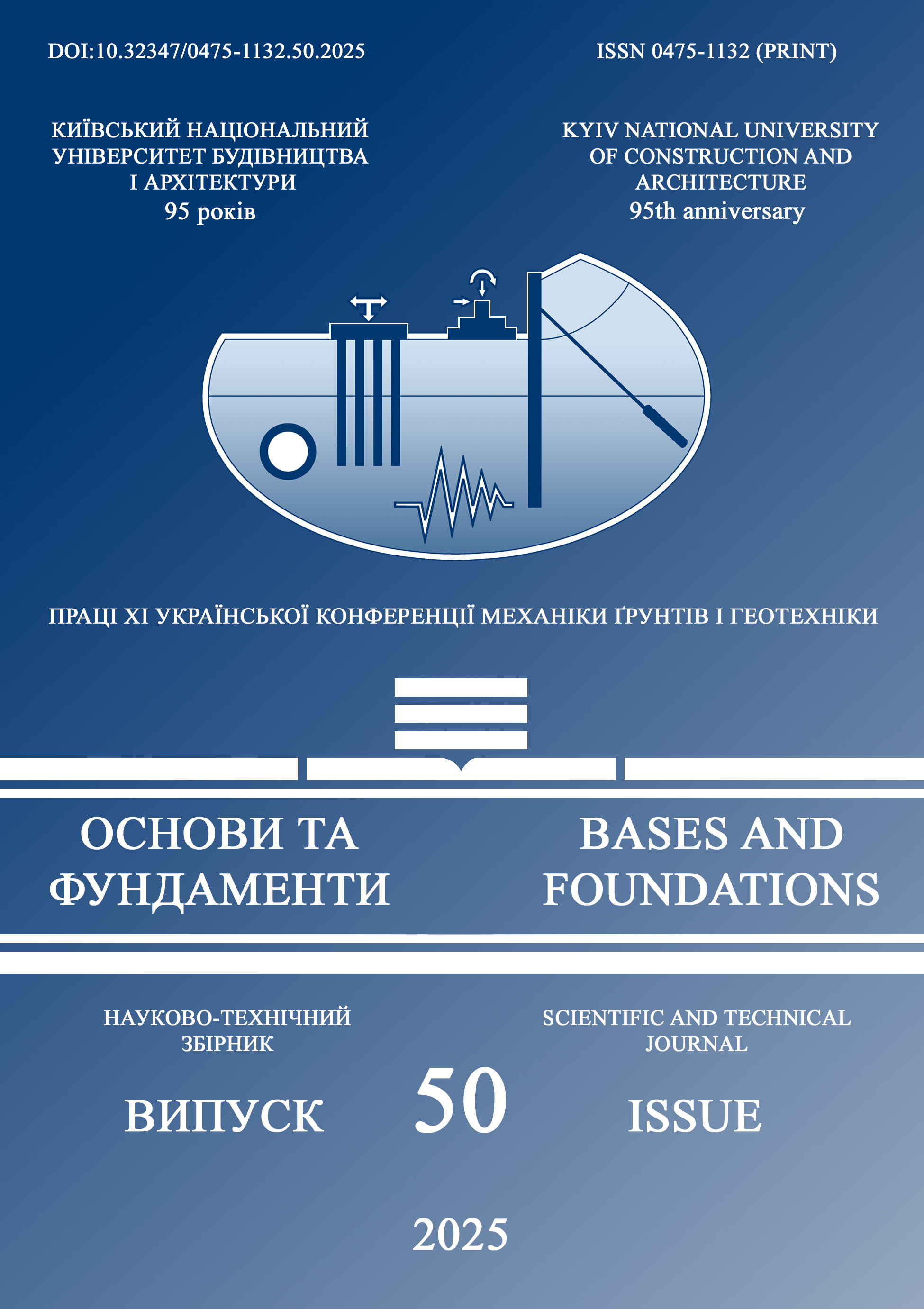Порівняння конструктивних особливостей заглиблених та незаглиблених споруд подвійного призначення на основі досвіду проектування
Основний зміст сторінки статті
Анотація
У дослідженні представлено порівняння конструктивних особливостей заглиблених та незаглиблених споруд подвійного призначення на основі досвіду проектування. Метою роботи є комплексний аналіз об‘ємно-планувальних та конструктивних рішень споруд подвійного призначення, розгляд особливостей розрахунків та конструювання, визначення висновків та рекомендацій при подальшому проектуванні.
Відзначено оновлення нормативно-правових документів та активізацію наукових досліджень в сфері проектування та будівництва захисних споруд в цілому. Переважна частина досліджень стосуються захисту об‘єктів критичної інфраструктури, фортифікаційних споруд та укриттів спеціального призначення. Моделювання таких споруд відбувається на основі чітко визначеного завдання – ударного навантаження прямого влучання, що залежить від типу загрози. Кількість досліджень щодо укриттів цивільного населення, що мають бути запроектовані відповідно до діючих нормативних вимог, де не передбачено розрахункових випадків на пряме влучання, на сьогодні обмежена.
З нормативних положень та досвіду проектування встановлено, що об‘ємно-планувальне рішення споруди подвійного призначення визначається, перш за все, з умови основного функціонального призначення. В житлових та громадських будівлях, найоптимальнішим варіантом влаштування споруд подвійного призначення є підземні приміщення, які в першу чергу відведено для зберігання автотранспорту (паркінги).
Для аналізу винесено три споруди подвійного призначення, що відрізняються між собою особливостями конструктивних схем, умовами заглиблення, величиною навантаження від дії ударної вибухової хвилі. Моделювання кожної споруди подвійного призначення виконане в просторовій постановці в ПК «SCAD» із урахуванням фізичної та геометричної нелінійностей. Врахування навантаження від дії ударної вибухової хвилі реалізоване квазістатичним методом.
Встановлено, що відповідно до нормативних положень, характер заглиблення споруди подвійного призначення визначає розрахункову величину навантаження від дії ударної вибухової хвилі , що у свою чергу впливає на напружено-деформований стан конструкцій. Зміна величини навантаження кількісно відрізняється при схемі з повним заглибленням, неповним заглибленням та повним незаглибленням.
Отримані результати демонструють, що з точки зору ефективного проектування заглиблені споруди подвійного призначення є більш доцільними на відміну від частково заглиблених та повністю незаглиблених.
Блок інформації про статтю

Ця робота ліцензується відповідно до Creative Commons Attribution 4.0 International License.
Автори, які публікуються у цьому журналі, погоджуються з наступними умовами: Автори залишають за собою право на авторство своєї роботи та передають журналу право першої публікації цієї роботи на умовах ліцензії Creative Commons Attribution License, котра дозволяє іншим особам вільно розповсюджувати опубліковану роботу з обов'язковим посиланням на авторів оригінальної роботи та першу публікацію роботи у цьому журналі. Автори мають право укладати самостійні додаткові угоди щодо неексклюзивного розповсюдження роботи у тому вигляді, в якому вона була опублікована цим журналом (наприклад, розміщувати роботу в електронному сховищі установи або публікувати у складі монографії), за умови збереження посилання на першу публікацію роботи у цьому журналі. Політика журналу дозволяє і заохочує розміщення авторами в мережі Інтернет (наприклад, у сховищах установ або на особистих веб-сайтах) рукопису роботи, як до подання цього рукопису до редакції, так і під час його редакційного опрацювання, оскільки це сприяє виникненню продуктивної наукової дискусії та позитивно позначається на оперативності та динаміці цитування опублікованої роботи (див. The Effect of Open Access).Посилання
Про регулювання містобудівної діяльнос-ті. Закон України №3038-VI (2025) (Укра-їна) https://zakon.rada.gov.ua/laws/show/3038-17
Захисні споруди цивільного захисту із Змінами № 1 та №2: ДБН В.2.2-5:2023 (2023) [Чинний від 2023.11.01]. К.: Мініс-терство розвитку громад, територій та ін-фраструктури України.
Азізов, Т., Люльченко, В. & Орлова, О. (2024) Швидкоспоруджувана захисна спо-руда цивільного захисту. Екологічна без-пека та природокористування, 50, 78–87.
Веселов, М., Забєділіна, А. (2023) Цивіль-ний захист населення в умовах воєнного стану. Зовнішня торгівля: економіка, фі-нанси, право, 4, 98-114. https://doi.org/10.31617/3.2023(129)09
Коцюруба, В.І., Білик, А.С., Веретнов, А.О., Гайдарли, Г.С., Борта, Р.М. & Тер-тишний, Б.І. (2022) Методика розрахунків та обґрунтування вимог до інженерного захисту об’єктів критичної інфраструкту-ри від БпЛА типу баражуючий боєприпас. Опір матеріалів і теорія споруд: наук.-тех. збірник, 109. 164-183.
Сахаров, В., & Литвин, О. . (2023). Вплив вибухової ударної хвилі на покриття захи-сної споруди критичної інфраструктури. Основи та Фундаменти, 47, 107–114. https://doi.org/10.32347/0475-1132.47.2023.107-114
Носенко, В., & Нечипоренко, Д. (2024). Принципи побудови числових моделей для дослідження впливу імпульсних нава-нтажень на заглиблені споруди. Основи та Фундаменти, 49, 55–61. https://doi.org/10.32347/0475-1132.49.2024.55-61
Pro rehuliuvannia mistobudivnoi diialnos-ti. Zakon Ukrainy №3038-VI (2025) (in Ukrainian) https://zakon.rada.gov.ua/laws/show/3038-17#Text
Zakhysni sporudy tsyvilnoho zakhystu iz Zminamy № 1 ta №2: DBN V.2.2-5:2023 (2023) [Chynnyi vid 2023.11.01]. K.: Ministerstvo rozvytku hromad, terytorii ta infrastruktury Ukrainy. (in Ukrainian).
Azizov, T., Liulchenko, V. & Orlova, O. (2024) Shvydkosporudzhuvana zakhysna sporuda tsyvilnoho zakhystu [The prefabri-cated civil defense structure]. Ekolohichna bezpeka ta pryrodokorystuvannia, 50, 78–87. (in Ukrainian).
Veselov, M., Zabiedilina, A. (2023) Tsyvilnyi zakhyst naselennia v umovakh voiennoho stanu [Civilian protection of the population under martial law]. Zovnishnia torhivlia: ekonomika, fi-nansy, pravo, 4, 98-114. (in Ukrainian). https://doi.org/10.31617/3.2023(129)09
Kotsiuruba, V.I., Bilyk, A.S., Veretnov, A.O., Haidarly, H.S., Borta, R.M. & Tertyshnyi, B.I. (2022) Metodyka rozrakhunkiv ta obgruntuvannia vymoh do inzhenernoho zakhystu obiektiv krytychnoi infrastruktu-ry vid BpLA typu barazhuiuchyi boieprypas [Methodology for calculating and justifying requirements for engineering protection of critical infrastructure objects from UAVs of the barrage munition type]. Opir materialiv i teoriia sporud: nauk.-tekh. zbirnyk, 109. 164-183. (in Ukrainian).
Sakharov, V., & Lytvyn, O. (2023). Vplyv vybukhovoi udarnoi khvyli na pokryttia zakhy-snoi sporudy krytychnoi infrastruktury [Impact of an explosive shock wave on the covering of a critical infrastruc-ture protection structure]. Bases and Foundations, 47, 107–114. (in Ukrainian). https://doi.org/10.32347/0475-1132.47.2023.107-114
Nosenko, V., & Nechyporenko, D. (2024). Pryntsypy pobudovy chyslovykh modelei dlia doslidzhennia vplyvu impulsnykh navantazhen na zahlybleni sporudy [Principles of constructing numerical models for studying the impact of impulse loads on recessed structures]. Bases and Foundations, 49, 55–61. (in Ukrainian). https://doi.org/10.32347/0475-1132.49.2024.55-61
